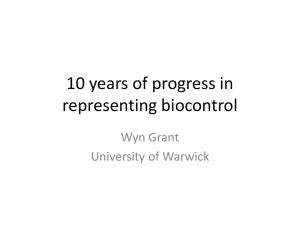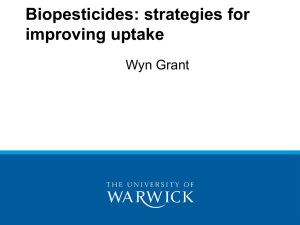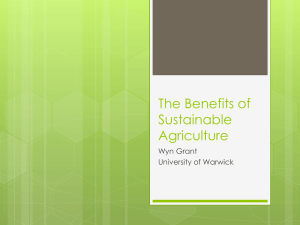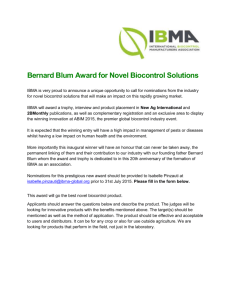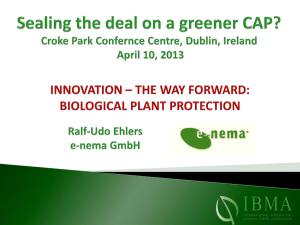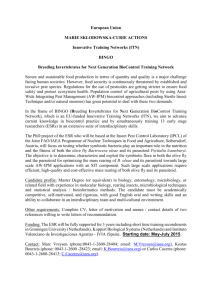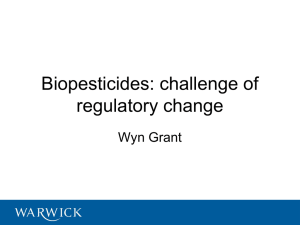1995 California Avocado Research Symposium pages 51-53
advertisement
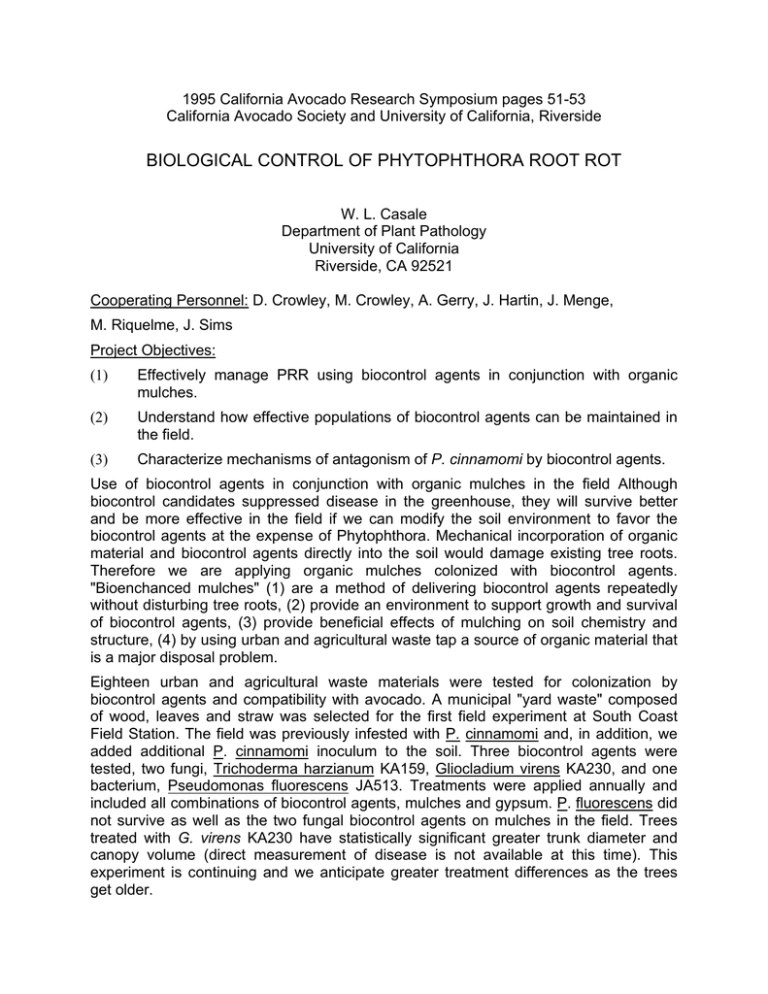
1995 California Avocado Research Symposium pages 51-53 California Avocado Society and University of California, Riverside BIOLOGICAL CONTROL OF PHYTOPHTHORA ROOT ROT W. L. Casale Department of Plant Pathology University of California Riverside, CA 92521 Cooperating Personnel: D. Crowley, M. Crowley, A. Gerry, J. Hartin, J. Menge, M. Riquelme, J. Sims Project Objectives: (1) Effectively manage PRR using biocontrol agents in conjunction with organic mulches. (2) Understand how effective populations of biocontrol agents can be maintained in the field. (3) Characterize mechanisms of antagonism of P. cinnamomi by biocontrol agents. Use of biocontrol agents in conjunction with organic mulches in the field Although biocontrol candidates suppressed disease in the greenhouse, they will survive better and be more effective in the field if we can modify the soil environment to favor the biocontrol agents at the expense of Phytophthora. Mechanical incorporation of organic material and biocontrol agents directly into the soil would damage existing tree roots. Therefore we are applying organic mulches colonized with biocontrol agents. "Bioenchanced mulches" (1) are a method of delivering biocontrol agents repeatedly without disturbing tree roots, (2) provide an environment to support growth and survival of biocontrol agents, (3) provide beneficial effects of mulching on soil chemistry and structure, (4) by using urban and agricultural waste tap a source of organic material that is a major disposal problem. Eighteen urban and agricultural waste materials were tested for colonization by biocontrol agents and compatibility with avocado. A municipal "yard waste" composed of wood, leaves and straw was selected for the first field experiment at South Coast Field Station. The field was previously infested with P. cinnamomi and, in addition, we added additional P. cinnamomi inoculum to the soil. Three biocontrol agents were tested, two fungi, Trichoderma harzianum KA159, Gliocladium virens KA230, and one bacterium, Pseudomonas fluorescens JA513. Treatments were applied annually and included all combinations of biocontrol agents, mulches and gypsum. P. fluorescens did not survive as well as the two fungal biocontrol agents on mulches in the field. Trees treated with G. virens KA230 have statistically significant greater trunk diameter and canopy volume (direct measurement of disease is not available at this time). This experiment is continuing and we anticipate greater treatment differences as the trees get older. We are using G. virens-colonized mulch as the basis for enhancing the biocontrol treatments. We have four bacteria, including P. fluorescens JA513, that have shown promise as biocontrol agents in greenhouse experiments. We plan to use these in combination with G. virens. However, the results of the South Coast Field Station experiment showed that P. fluoresens did not survive well on the mulch used for G. virens. An alternative is to deliver bacterial biocontrol agents through the irrigation system, allowing the application of high populations of bacteria at even more frequent intervals. A new field experiment includes G. virens-colonized mulch plus one of four bacterial biocontrol agents applied as a drench at frequent intervals. In order to randomize the treatments with different bacteria, we substituted a drench instead of modifying the existing irrigation system for this experiment. This spring we plan to set up a similar experiment at a site with existing infected trees. Survival and competitiveness of biocontrol agents For biocontrol agents to be effective, they have to survive and remain active in the face of competition from indigenous microorganisms. As the basis of enhancing biocontrol, we are studying mechanisms that are important to the competitiveness of biocontrol agents. Siderophores are chemicals produced and used by microorganisms and plants to scavenge iron necessary for survival. Iron is critical for the growth and survival of bacteria and fungi, but is often not very available, particularly in neutral to high pH soils. These compounds have been implicated in biocontrol of disease by fluorescent pseudomonad bacteria. Siderophores are produced in high amounts by G. virens and Trichoderma spp. We have been using siderophore-production mutants to examine the role of siderophores in the competitiveness of fungal biocontrol agents. Dr. D. Crowley, who has done extensive work on siderophores, is cooperating with us on this project. We have found that field isolates of these fungi vary in the amount of siderophores produced under particular conditions. Also, we have discovered Trichoderma containing different nuclear types and virus-like elements that are associated with changes in siderophore production and sporulation. Mechanisms of antagonism of P. cinnamomi by biocontrol agents We are continuing characterization of antibiotics from one of our biocontrol agents, Verticillium tenerum. These antibiotics are interesting because they appear to be fairly specific for Phytophthora spp. The specificity of mechanisms of biocontrol may be important to control P. cinnamomi without inhibiting other naturally-occurring or introduced beneficial microorganisms. The specificity and mode of action of this antibiotic could also potentially be the basis for new Phytophthora-specific fungicides that have little or no non-target effects. Since large amounts of these antibiotics are required for chemical characterization, considerable time has been spent in determining the optimum conditions for production and in actually producing these antibiotics. Dr. J. Sims, a natural products chemist, has been assisting us in identifying and characterizing antibiotics and siderophores produced by potential biocontrol agents.
